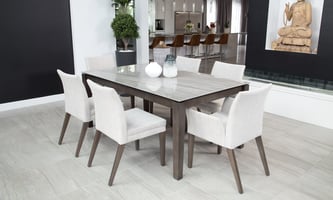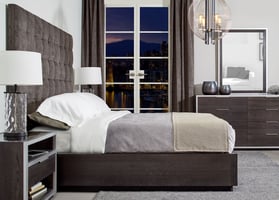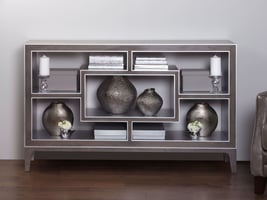In your search for quality dining room furniture, you’ve probably run across the name Bermex once...
Solid Wood vs. Veneered Wood (Benefits, Problems, Misconceptions, Recommendations)
.png?width=1000&name=WOODTITLE%20(1).png)
You want wood furniture, that much you’re sure of. But now you’re faced with whether you should invest in solid wood or wood veneered furniture. There’s a lot of information out there about either option, but how are you supposed to know which is going to be the best fit for you and your home?
At McElheran’s Furniture + Design, we’ve carried both solid wood and wood veneered furniture since we opened in 1994 – because it’s always good to give you options. And both options are great, but since they’re both wood, are they different enough for you to be able to determine which is better?
In this article, McElheran’s owner, Jeff McElheran, will compare solid wood and wood veneered furniture. We’ll discuss the benefits, problems, misconceptions (because there seems to be a lot - especially with veneered wood), and offer some recommendations, too.
So, not only will you have a clearer understanding of what solid wood and veneered wood are all about you’ll also have a better idea of what will work best for you.
What is a wood veneer?
A veneer is still a wood product. It’s not plastic, laminate, or wood-grain paper – it’s actual wood. It’s just manipulated and made into furniture a little differently from solid wood.
A wood veneer is a thin slice of natural wood that is attached to a board, usually plywood or fibreboard (like MDF or medium-density fibreboard). The slice of wood and board are held together by a strong glue.
Plywood takes thin pieces of wood and layers them by alternating the grain of the wood; thus, making a more solid structure for the veneer to attach to.
Fibreboard – or more specifically, medium density fibreboard (MDF) – is a furniture-grade engineered board that is made from ground-up wood particles that have been glued together. Again, adding to the strength of the entire veneered piece.
Benefits of wood veneers
Detailing
With wood veneers, there’s more opportunity to add design and detail to your furniture. An inlay, for instance, is a wood pattern recessed into a larger piece of wood. Inlays can be a simple pattern or as elaborate as a mosaic of different types of wood.
Bookmatching can also be done with veneered wood. This occurs when two strips of veneer are laid in such a way that one strip mirrors the other – as if you opened a book.
Less prone to shifting
Because of the way veneers are manufactured, particularly the high-quality ones, you won’t experience the same kind of expansion or contraction that can occur with solid wood pieces. Veneered wood furniture is not necessarily stronger than solid wood, but it’s certainly structurally stable because of its construction.
Our Edmonton climate can be hard on furniture with our cold and dry winters, but veneered wood is much less sensitive to humidity changes in the air.
Problems with wood veneers
Harder to refinish
Because a wood veneer is usually quite thin, it’s much more difficult to sand down your furniture, should you want to.
You can still remove the finish and lightly sand a veneer down to refinish it, but it’s not quite as easy as it is with a solid piece of wood. If you sand a veneer down too far, you’ll end up exposing the board that the veneer is glued to.
Potential for cracks
If the wood that makes up the board and the veneer are not properly dried and constructed together, there could be differences in shrinkage and swelling. When that happens, tiny cracks can form on the veneer which is known as veneer checking.
Off-gassing
Off-gassing occurs when furniture, because of the manufacturing process, releases chemicals in the air.
Both solid wood and veneered wood off-gas, but because of the higher amounts of glue used to adhere a strip of veneer to a board, veneered wood will potentially off-gas for a longer time.
Vulnerable to moisture, heat, and sunlight
There are some external factors that can wear on your veneered wood furniture – actually, this goes for all wood furniture. Moisture left on your wood for too long can lead to swelling, exposure to extreme heat (like a pot fresh off the stove) could cause heat damage, and direct sunlight can dry out and fade the colour of your wood furniture.
Misconceptions about wood veneers
“It’s not real wood”
Veneered wood is absolutely real wood. The veneer itself is a strip of wood and the board it’s attached to is also made up of wood. It’s just constructed and manipulated differently from its solid counterpart, but it’s still real wood!
“It's bad quality”
Some people think that just because a piece of furniture contains veneered wood, it automatically makes it lower quality. And that’s simply not true! Not in most cases, anyway.
If veneered wood is well-made, using furniture-grade fibreboard and a good quality veneer, you’re going to get the same kind of quality that you would find in a solid wood piece of furniture.
“It’s cheaper”
To snowball on to the previous misconceptions, when it is assumed that veneered wood isn’t real or that it’s lower in quality, it is also assumed that the price should reflect that. But because high-quality veneered wood is real and well-made, you may find that the prices are comparable to solid wood or, at times, even more expensive.
Who is wood veneered furniture a good fit for?
If you love the look of wood and appreciate the intricacies that lay-ins and bookmatching can add to a piece of furniture, veneered wood can absolutely give you that desired style.
There’s also a little more consistency with veneered wood. If you fall in love with something on a showroom floor and order it in hoping it will look exactly the same, you’re more likely to get that with a veneered piece. Not that a solid wood piece would be far off, but you are dealing with nature’s imperfections and every piece of solid wood is different.
What is solid wood furniture?
Solid wood furniture is made exclusively (apart from areas of upholstery or metal detailing) from natural wood joined together to make an entire piece of furniture. Different species are used in furniture, like oak, maple, walnut, cherry, and mahogany.
Benefits of solid wood furniture
Structurally solid
Solid wood is dense, strong, and durable. And there’s something comforting about having a piece of furniture in your home that you know can withstand the elements – because it has! You’re basically putting a solid tree trunk in your space. And that piece of solid wood should be able to last in your home for generations.
Versatility
Perhaps your solid wood furniture is perfect in every single way. Or maybe, you’d like to take a little creative licensing and customize the look of it. With solid wood, the manufacturers have more freedom to sand down areas, refinish the entire piece, or carve in specific details.
More natural
Again, most furniture will off-gas to some degree, but solid wood is almost as natural as you can get with furniture. Making solid wood furniture does require the use of stains, finishes, and some glue, but off-gassing is pretty minimal, as compared to a veneered wood piece.
Problems with solid wood furniture
Shifting of the wood
All wood furniture shifts, depending on the climate. It’s usually not terribly noticeable, but changes in humidity could temporarily warp your wood. And solid wood is much more susceptible to expanding and contracting than a veneered piece.
Vulnerable to moisture, heat, and sunlight
Solid wood is a living, breathing material. And although solid wood is extremely durable, there are certain external factors that can wear on your furniture – just like veneered wood. Moisture left on your wood for too long can lead to swelling, exposure to extreme heat could cause heat damage, and direct sunlight can dry out and fade the colour of your wood furniture.
Misconceptions about solid wood furniture
“It’s not very modern”
Solid wood furniture is often associated with traditionally grand dining sets and regal poster beds. Solid wood is all those things, sure, but it can also be fashioned into very modern pieces. As we mentioned before, solid wood offers versatility – it’s much easier to reshape, sand down, and carve in comparison to a veneered piece.
“It’s not meant for Edmonton’s climate”
The climate in Edmonton can be harsh with our cold, dry, and long (oh, so long) winters. It’s true that solid wood will shift as humidity changes, but it doesn’t mean that you can’t have solid wood in your Edmonton home.
If your furniture has been acclimatized properly, the changes in your solid wood are negligible. There are a couple of Canadian furniture makers (like Durham Furniture and TH Solid Wood) that specialize in solid wood, too, so you know you’re getting a product that can withstand our climate.
If, however, you fell in love with a spectacular solid wood piece while on vacation in say, Bali, that furniture may be more susceptible to cracking or splitting when you bring it home. It’s not because it’s poorly made, it’s simply because it was manufactured for a more humid climate than ours.
Who is solid wood furniture a good fit for?
If you love the idea of going as natural as possible with the furniture in your home, then solid wood is definitely for you. There’s a lot less that goes into the manufacturing process because Mother Nature practically built the table for you. Plus, your furniture will have that perfectly imperfect charm that you can only get from nature.
Solid wood or veneered wood: Which should I choose for my furniture?
This is one of those situations where it really comes down to personal preference.
Jeff McElheran suggests browsing and finding something that catches your eye stylistically and quality-wise. If you like the look of a piece of furniture and can tell that it will last in your home, whether it’s veneered wood or solid wood is, well, that’s kind of secondary. Because the thing is, neither is really better than the other. They’re just different!
Even the maintenance is pretty much the same. Read “How to Extend the Life of Your Wood Table,” so you know exactly what you’re getting into by buying a wood piece – veneered or solid.
At McElheran’s Furniture + Design, we carry almost a 50/50 split of veneered wood and solid wood to give you ample options for both. If you’re in the Edmonton area, drop by our showroom to see which type of wood furniture is going to work best for you and your home.

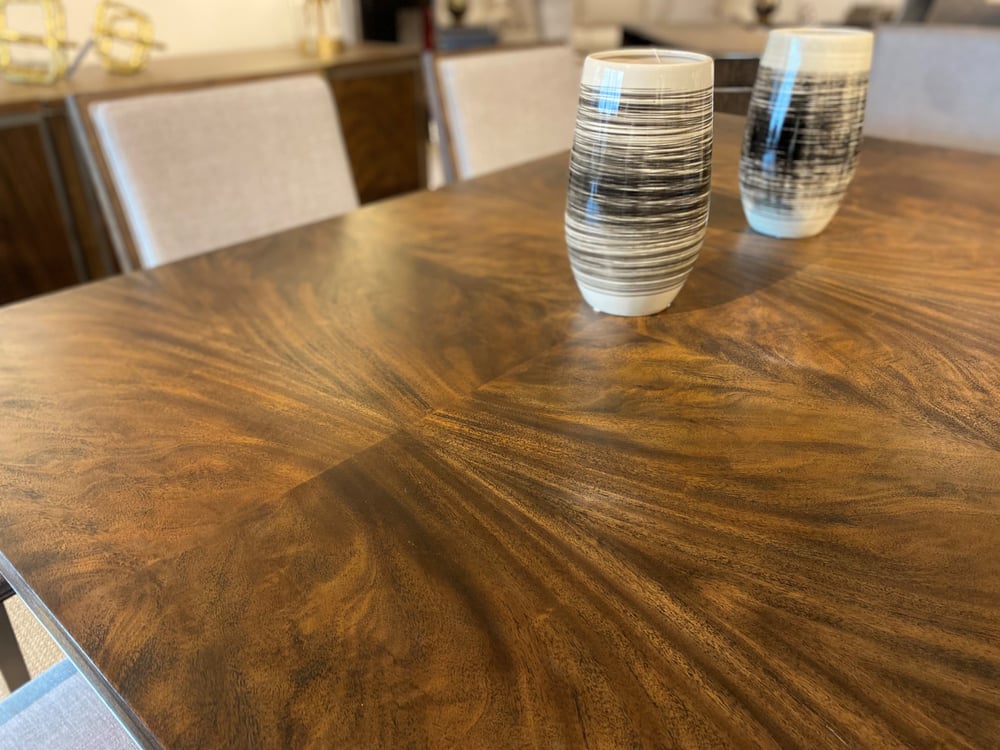
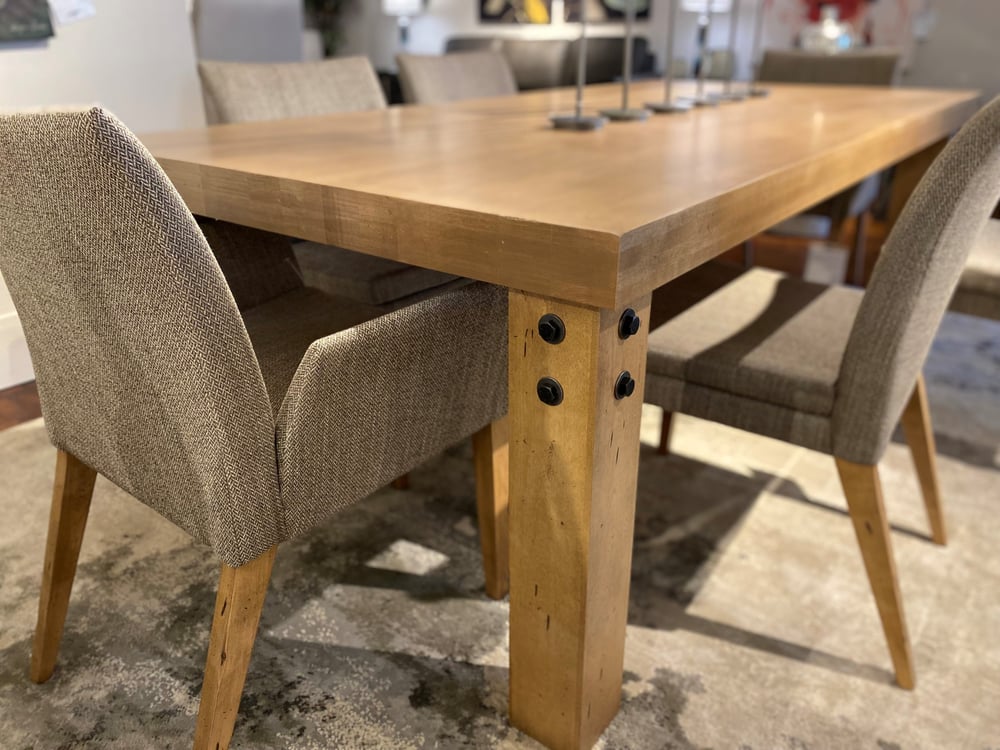
-min-1.png?width=800&name=DesignButton(png)-min-1.png)
